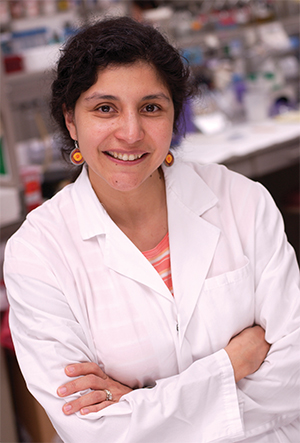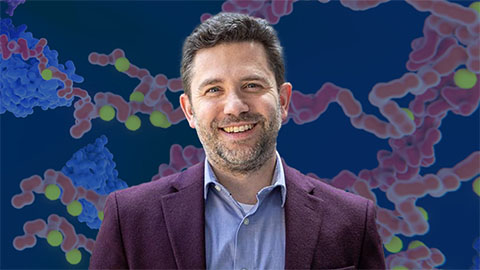Mentors guided a career that now aims at a cure
Marina Ramirez-Alvarado, a professor of biochemistry and molecular biology at the Mayo Clinic in Rochester, Minnesota, studies the molecular determinants that drive protein misfolding and amyloid formation in light chain amyloidosis, with the goal of ameliorating the organ damage caused by this disease.
 Marina Ramirez-Alvarado studies light chain amyloidosis, a rare disease caused by the build-up of an abnormal protein. courtesy of the mayo clinic
Marina Ramirez-Alvarado studies light chain amyloidosis, a rare disease caused by the build-up of an abnormal protein. courtesy of the mayo clinic
Ramirez-Alvarado earned a B.S. in biochemistry and an M.S. in biotechnology at the Universidad Nacional Autonoma de Mexico. She earned her Ph.D. in biology at the European Molecular Biology Lab, Ruprecht-Karl-Universitat Heidelberg.
Here, she talks about how she became interested in protein research and describes how numerous mentors guided her on her career path and supported her research.
What key experiences and decisions enabled you to reach your current position?
When I decided to study abroad, I came to the realization that scientists in developed countries were not better than my colleagues in Mexico. This was key for me, because I was always intimidated by the big shots in the field. It helped me to learn more from their work and to believe that I could make a difference in the field of biochemistry.
How did you first become interested in science?
When I was 15, I wanted to become a travel agent because I loved traveling and seeing new places. A friend of mine in middle school, Margarita Castrejón Balderas, pointed out that my talent for science would be wasted at a travel agency. She helped me develop my love for chemistry. When I went to college, I minored in food chemistry because I wanted to develop nutritious food to solve world hunger. In my second year, I learned about proteins from my biochemistry professor, Homero Hernandez, and I fell in love with their complexity and their beauty. Soon after that, I started doing protein research.
Were there times when you failed at something critical to your path? How did you regroup and get back on track?
I was very naive about authorship as a student, and I gave away my position in a joint first authorship as a sign of friendship. This happened at a time when journals didn’t give much credit to the second name in the list. After that experience, I discuss authorship even before we start writing the first draft of a paper.
When I was a junior assistant professor, my grants and papers constantly were rejected. I felt very inadequate and questioned my ability to run an independent research program. My mentor, Grazia Isaya, told me that, in general, female scientists take failure as a sign of inadequacy. Hearing these words from an established investigator motivated me to keep trying. Another colleague, Tom Spelsberg, used to tell me, “Persistence is what we need in academe — keep trying, kiddo!”
What are your hobbies?
I am a martial artist. I started taking taekwondo classes with my son, and now we are both black belts. I sing and play guitar in a band. I am a new but enthusiastic gardener for native species and pollinator-friendly plants.
About the Research Spotlight
American Society for Biochemistry and Molecular Biology’s Research Spotlight highlights distinguished biomolecular and biomedical scientists from diverse backgrounds as a way to inspire up-and-coming scientists to pursue careers in the molecular life sciences. Eligible candidates include Ph.D. students, postdoctoral fellows, and new or established faculty and researchers. To nominate a colleague for this feature, contact the education department.
What was the last book you read?
“The Hot Zone” by Richard Preston (thanks, Dr. Sara Holditch, for the recommendation). It’s a terrifying story about filoviruses written in 1995 and very relevant today. I followed it up with “Love is the Cure: On Life, Loss and the End of AIDS” by Elton John — a human, inspiring story about the AIDS epidemic in the 1980s.
Do you have any heroes, heroines, mentors or role models?
I have many, starting with Homero Hernández, who taught me cell biology and biochemistry as an undergraduate. My first research mentor, Agustin Lopez-Munguía, taught food enzymology. Agustin became my undergraduate thesis research mentor and is now a dear friend. Eduardo Bárzana taught industrial fermentations and helped me decide my path for graduate school.
During my Ph.D., Anne Ephrussi was my first female scientist role model. She was a scientist and a mother who inspired me to seek work-life satisfaction and integration.
During my postdoctoral training, Andrew Miranker was a role model. He was our next-door lab neighbor. I was the only one in my lab working on amyloid, and Andrew had just started his laboratory working on amyloid studies.
As an assistant professor, my first mentor was Frank Rusnak, who helped me so much in a very short time and died tragically six months after I started to work at Mayo. Grazia Isaya became my mentor at that point and offered me her wisdom and calm during the hard days of rejections.
Outside Mayo, I received support from Jeff Kelly, who has always supported my research. When I was invited to be an editor in chief for a protein misfolding book, Jeff agreed to edit it with me and recruited Chris Dobson, who was a pleasure to work with and whose work I have admired since my years in graduate school.
Joel Buxbaum has been a fantastic role model since we met in Tours, France, during the Amyloidosis Symposium. Joel has been a source of wisdom and good humor in my life as a professor. Writing a book chapter with him was an incredible experience.
An unusual role model and hero is Tim Stepanek, the first amyloidosis patient I met. Tim was involved in ways I never thought patients would get involved. He was the first person to believe with all his heart in what I was doing. He advised me in ways he probably never realized. He faced a devastating disease with grace and dignity. When he died 11 years ago, Tim trusted me with the task of trying to understand his disease so people like him would not have to die anymore.
What keeps you working hard every day?
I have the honor to conduct biochemical studies on a rare, devastating, incurable disease. What keeps me working hard every day is the notion that one day, possibly before I retire, our research will contribute to finding a cure for light chain amyloidosis.
Interacting with young scientists in training and seeing them learn and grow is inspiring and rewarding for me. I love learning new things every day.
Enjoy reading ASBMB Today?
Become a member to receive the print edition four times a year and the digital edition monthly.
Learn moreGet the latest from ASBMB Today
Enter your email address, and we’ll send you a weekly email with recent articles, interviews and more.
Latest in People
People highlights or most popular articles

Alrubaye wins research and teaching awards
He was honored at the NACTA 2025 conference for the Educator Award and at the U of A State and National Awards reception for the Faculty Gold Medal.

Designing life’s building blocks with AI
Tanja Kortemme, a professor at the University of California, San Francisco, will discuss her research using computational biology to engineer proteins at the 2026 ASBMB Annual Meeting.

Jordahl named Gilliam Fellow
He will receive three years of funding to support his thesis research.

Bibel named assistant professor
She began her position at Loyola Marymount University in August 2025.

Unraveling the language of histones
Philip Cole presented his research on how posttranslational modifications to histones are involved in gene expression and how these modifications could be therapeutically targeted to treat diseases like cancer.

Cotruvo named Blavatnik award finalist
He received a $15,000 prize and was honored at a gala in October.
